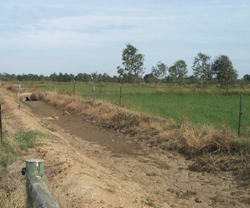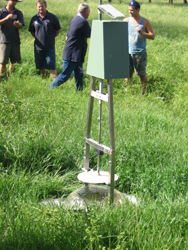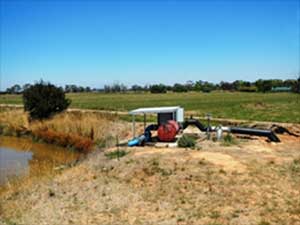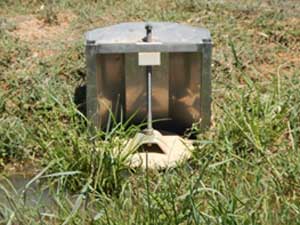4.1.2.3 - What should be the size of my channels and drains?
Return to Main Menu | Return to Step 4 | Return to Step 4.1 | Next Step
To view the information PDF above, requires the use of a PDF reader. This can be installed for free from the Adobe website (external link).
Figure 6: A pipe and riser system pump and bay outlet
Drains and drainage reuse – Good drainage and a reuse system are essential for the efficient operation of border-check systems. Information on farm drains and drainage reuse systems is presented in the DPI “Target 10" Irrigation and Drainage Reference Manual” (Mulcahy and Schroen, 1993) (external link).
Page top
| Properly designed farm channels and drains are important for the operation of border-check systems to get water onto the bays at the desired flow rate, and to get drainage off the bays in a reasonable time. This is particularly important in the SIR where the landscape is relatively flat, often resulting in limited head (or elevation) availability to ensure good flows. Channels – In the SIR, water is commonly supplied to the farm by gravity from the Goulburn-Murray Water channel system, usually through a through an electromagnetic, or magflow, meter.In some cases where head in the supply system is insufficient to supply water by gravity, pumping will be necessary. For more information on farm channels see “Farm Channels for Border Check Irrigation” (Rural Water Commission of Victoria 1991 - now Goulburn-Murray Water), and the DPI “Target 10 (external link) Irrigation and Drainage Reference Manual” (Mulcahy and Schroen, 1993) (external link). |  The farm channel and structures must be designed to suit the system |
To view the information PDF above, requires the use of a PDF reader. This can be installed for free from the Adobe website (external link).
| Pipe and risers – The farm channel system can be replaced by pipes, with water being piped to individual bays. This usually requires the installation of a pump. This system offers considerable advantages: - land otherwise occupied by channels can be used productively; - access is not restricted by channels; - bays can be irrigated in any sequence; - there are no seepage and evaporation losses; - there is no channel maintenance such as weed control; and - channels don’t have to be filled and drained. Pipe and riser systems have to be properly designed to match pumps, flow rates and pipe diameters. Local suppliers are able to give advice. The disadvantages of pipe and risers are mainly the substantial capital installation costs and the ongoing pumping costs. |  An automated pipe and riser outlet |
 |  |
Drains and drainage reuse – Good drainage and a reuse system are essential for the efficient operation of border-check systems. Information on farm drains and drainage reuse systems is presented in the DPI “Target 10" Irrigation and Drainage Reference Manual” (Mulcahy and Schroen, 1993) (external link).


